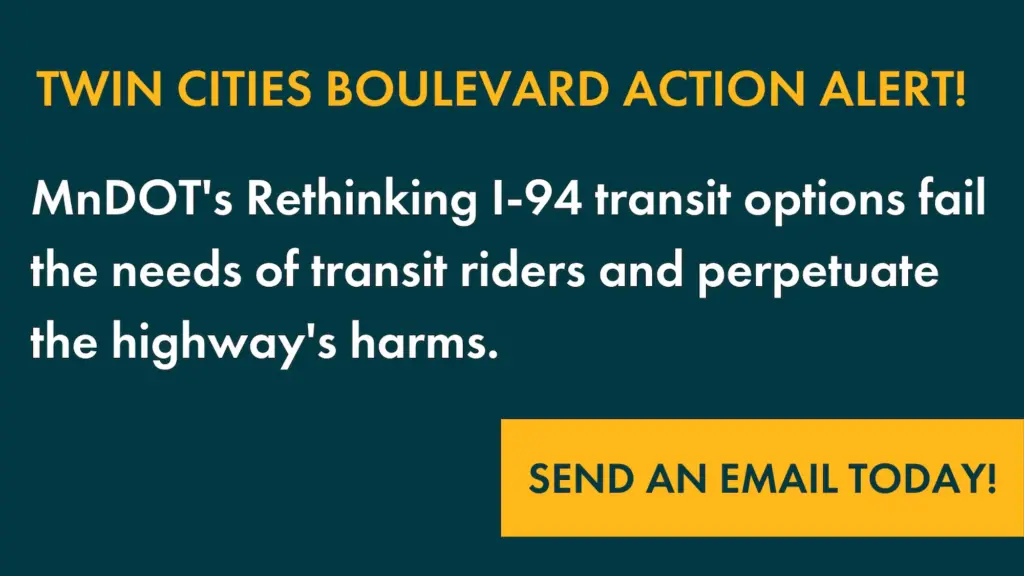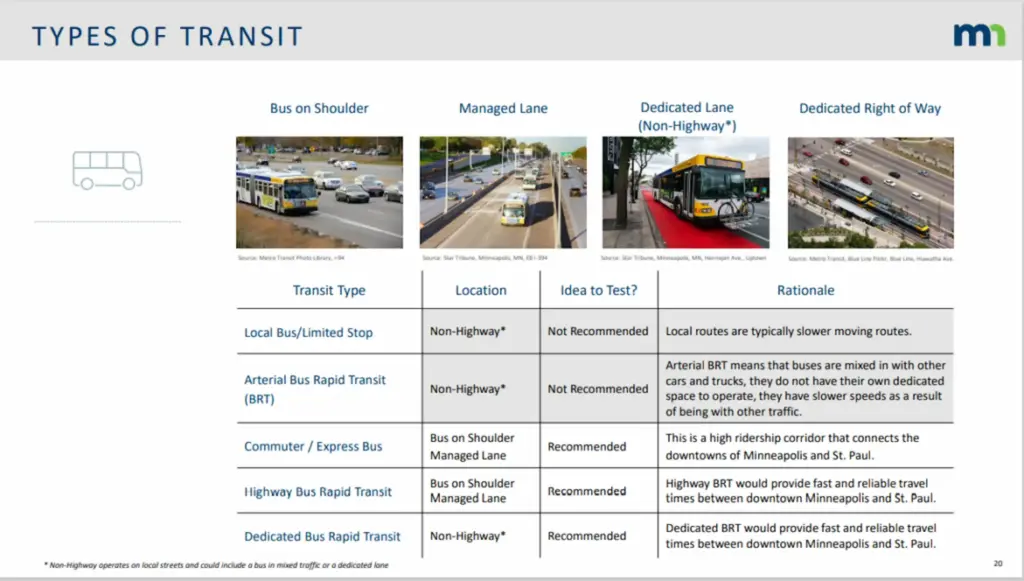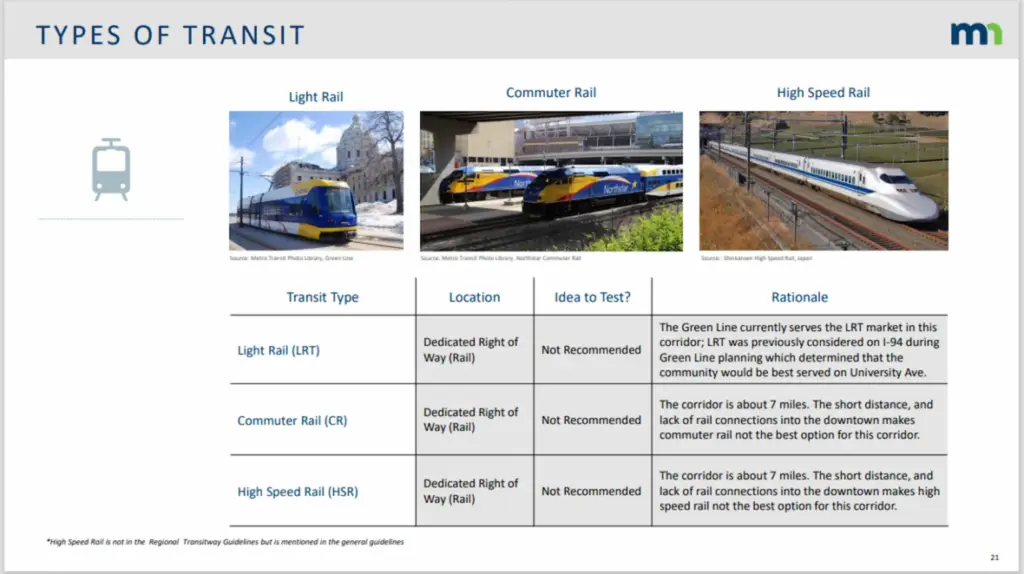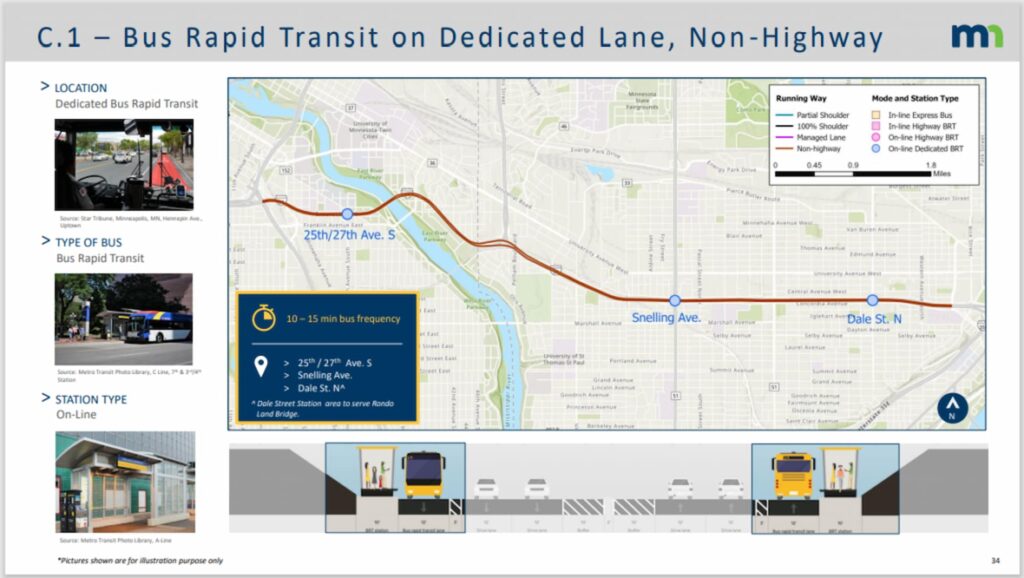

Take action by sending an email & attending an upcoming feedback session.
Next week, MnDOT will host a virtual meeting and in-person open house to share updates on the Rethinking I-94 transit study, including the recommended transit options for the project. These are the options that will continue to be studied and will be used to form the upcoming Rethinking I-94 project alternatives.
We have obtained a copy of the presentation slides, which is embedded below.
Rethinking-I-94-Transit-Study-PresentationDownload
All but one of the recommended transit options for Rethinking I-94 would rebuild the highway and perpetuate its harms.
In summary, the recommended options fail to address the needs of transit riders and ignore the thousands of community members who have called on the agency to repair the highway’s harms and expand access to fast, affordable and sustainable transportation options.
Better transit access is a critical need in the Rethinking I-94 project corridor, especially for the 28% of households who do not own a car. Despite this, MnDOT’s transit options put moving more car and truck traffic above the needs of transit dependent households.
Major Concerns
- It is unclear if any of the studied options include a full, at-grade boulevard conversion. This ignores the thousands of community members who have shared their support for the Twin Cities Boulevard to reconnect all neighborhoods in the corridor.
- The Twin Cities Boulevard seeks to improve transit access on the corridor by adding a combination of new service types, including local bus and rapid transit. However, MnDOT is proposing to eliminate future study of new local and arterial bus rapid transit on the corridor. (Slide 20)
- MnDOT is proposing to eliminate further study of all light rail and passenger rail options (Slide 21)
- The only non-highway transit option (Option C.1) that is proposed to advance includes just three stations and fails to serve most of the corridor, including Prospect Park, Merriam Park, Lex-Ham and St. Anthony Park (Slide 34)
- All but one of the recommended options would rebuild the highway (Slide 35)
- Despite MnDOT saying that no assumptions have been made for the project corridor, the transit options included in the presentation appear to assume that a land bridge will be built over the highway. Slide 17 includes the statement “Dale Street Station area to serve Rondo Land Bridge.”
- Many options for improving transit on the corridor were never studied, including a new subway tunnel that would run beneath the boulevard and connect downtown Minneapolis and Saint Paul. This has been one of the most common suggestions in the Twin Cities Boulevard feedback survey.



Additional Concerns and Ongoing Questions
- Slide 10: It is unclear how the “Environmental” measure will be evaluated. This measure should include not be limited to the transit vehicles themselves and should include the transit options ability to reduce driving (often measured by vehicle miles traveled or “VMT”) and the resulting reduction in air pollution and green house gas emissions
- Slide 10: Is is unclear if the “Accessibility via Transit” measure consider possible land use changes that would result from the Rethinking I-94 project. This measure should include the thousands of new homes and businesses that would be created on reclaimed highway land via a boulevard conversion.
- Slide 10: The “Complexity and Cost” measure aims to “support reasonable cost and implementation.” This cost benefit analysis should consider social costs and externalities beyond the cost of construction, including costs to public health, the climate, tax base, and ongoing maintenance costs.
- Slide 12: The project corridor excludes most of downtown Minneapolis, downtown Saint Paul and the University of Minnesota. Transit on the Rethinking I-94 corridor will directly serve these areas. The transit study area should be expanded to include all of downtown Minneapolis, downtown Saint Paul and the University of Minnesota
- Slide 19: The features listed under the different transit modes are inaccurate and biased toward highway options. Level boarding is listed as a feature of highway BRT, however this has generally not been the case in this region. Additionally, level boarding and all-door boarding are missing from the list of light rail features.
We are calling on MnDOT & Metro Transit to:
- Add a wide variety of non-highway transit options that are compatible with a boulevard conversion and reconnect the entire corridor
- Study comprehensive solutions that include a combination of new local, rapid and express transit service and serve every neighborhood in the project corridor
- Restore rail options and study new rail connections into the downtowns
- Add options that repurpose the I-94 trench for grade separated transit, including a new subway tunnel and busway
- Expand ridership modeling to include the new residents & businesses that would result from a boulevard conversion
There are two ways to take action:
1. Click to send an email to MnDOT, Metro Transit, and other Rethinking I-94 project decision makers to demand that better transit options be added before the project moves forward.
2. Share your vision for transit on the corridor & your support for the Twin Cities Boulevard at an upcoming MnDOT engagement session for Rethinking I-94:
- Tuesday, October 11: 9:00 – 10:00 AM: Virtual Transit Study Public Meeting
- Wednesday, October 12: 8:00 AM – 8:00 PM: Transit Study Open House, Hallie Q. Brown Community Center, 270 N. Kent St., St. Paul, MN 55102